Report: Supply Chain Management Analysis of Seven-Eleven Japan (SEJ)
VerifiedAdded on 2021/06/18
|8
|2021
|80
Report
AI Summary
This report provides an in-depth analysis of Seven-Eleven Japan's (SEJ) supply chain management, focusing on its integrated information system, inventory management, and strategic competitive advantages. The company's success is attributed to its agile supply chain, which offers convenience, product availability, and favorable prices. The report examines SEJ's fully integrated information system, which monitors the entire supply chain, from branches to headquarters, enabling real-time market trend analysis and efficient inventory management. The study further discusses the company's use of a computerized system for inventory control and strict distributor terms. Recommendations include the adoption of Enterprise Resource Planning (ERP) systems to automate processes, improve decision-making, and enhance vendor performance monitoring. The potential benefits of implementing a centralized ERP system include improved performance, faster decision-making, and cost reduction. By implementing the recommendations, SEJ can further improve its supply chain management, maintain its competitive edge, and adapt to changing business environments.
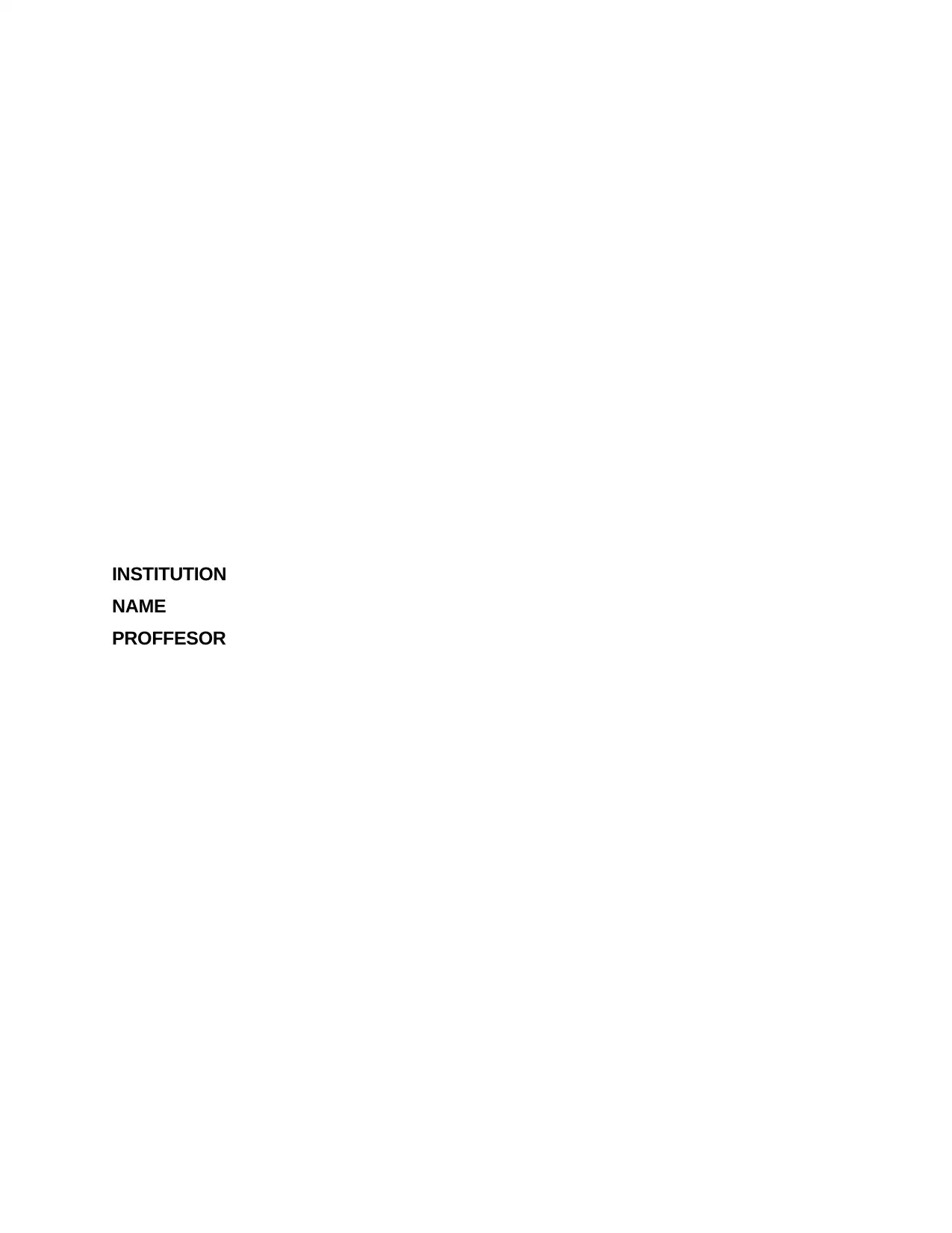
INSTITUTION
NAME
PROFFESOR
NAME
PROFFESOR
Paraphrase This Document
Need a fresh take? Get an instant paraphrase of this document with our AI Paraphraser
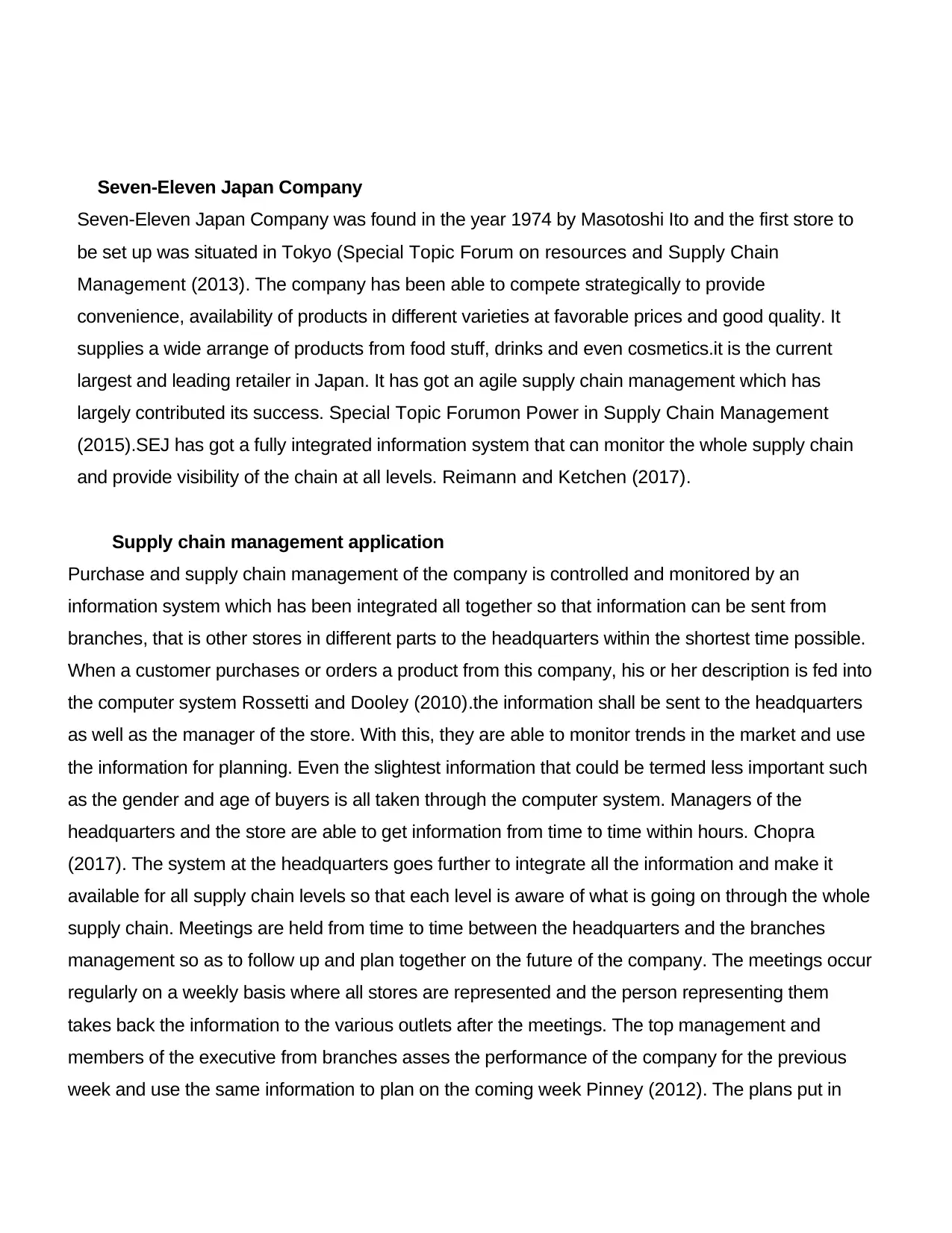
Seven-Eleven Japan Company
Seven-Eleven Japan Company was found in the year 1974 by Masotoshi Ito and the first store to
be set up was situated in Tokyo (Special Topic Forum on resources and Supply Chain
Management (2013). The company has been able to compete strategically to provide
convenience, availability of products in different varieties at favorable prices and good quality. It
supplies a wide arrange of products from food stuff, drinks and even cosmetics.it is the current
largest and leading retailer in Japan. It has got an agile supply chain management which has
largely contributed its success. Special Topic Forumon Power in Supply Chain Management
(2015).SEJ has got a fully integrated information system that can monitor the whole supply chain
and provide visibility of the chain at all levels. Reimann and Ketchen (2017).
Supply chain management application
Purchase and supply chain management of the company is controlled and monitored by an
information system which has been integrated all together so that information can be sent from
branches, that is other stores in different parts to the headquarters within the shortest time possible.
When a customer purchases or orders a product from this company, his or her description is fed into
the computer system Rossetti and Dooley (2010).the information shall be sent to the headquarters
as well as the manager of the store. With this, they are able to monitor trends in the market and use
the information for planning. Even the slightest information that could be termed less important such
as the gender and age of buyers is all taken through the computer system. Managers of the
headquarters and the store are able to get information from time to time within hours. Chopra
(2017). The system at the headquarters goes further to integrate all the information and make it
available for all supply chain levels so that each level is aware of what is going on through the whole
supply chain. Meetings are held from time to time between the headquarters and the branches
management so as to follow up and plan together on the future of the company. The meetings occur
regularly on a weekly basis where all stores are represented and the person representing them
takes back the information to the various outlets after the meetings. The top management and
members of the executive from branches asses the performance of the company for the previous
week and use the same information to plan on the coming week Pinney (2012). The plans put in
Seven-Eleven Japan Company was found in the year 1974 by Masotoshi Ito and the first store to
be set up was situated in Tokyo (Special Topic Forum on resources and Supply Chain
Management (2013). The company has been able to compete strategically to provide
convenience, availability of products in different varieties at favorable prices and good quality. It
supplies a wide arrange of products from food stuff, drinks and even cosmetics.it is the current
largest and leading retailer in Japan. It has got an agile supply chain management which has
largely contributed its success. Special Topic Forumon Power in Supply Chain Management
(2015).SEJ has got a fully integrated information system that can monitor the whole supply chain
and provide visibility of the chain at all levels. Reimann and Ketchen (2017).
Supply chain management application
Purchase and supply chain management of the company is controlled and monitored by an
information system which has been integrated all together so that information can be sent from
branches, that is other stores in different parts to the headquarters within the shortest time possible.
When a customer purchases or orders a product from this company, his or her description is fed into
the computer system Rossetti and Dooley (2010).the information shall be sent to the headquarters
as well as the manager of the store. With this, they are able to monitor trends in the market and use
the information for planning. Even the slightest information that could be termed less important such
as the gender and age of buyers is all taken through the computer system. Managers of the
headquarters and the store are able to get information from time to time within hours. Chopra
(2017). The system at the headquarters goes further to integrate all the information and make it
available for all supply chain levels so that each level is aware of what is going on through the whole
supply chain. Meetings are held from time to time between the headquarters and the branches
management so as to follow up and plan together on the future of the company. The meetings occur
regularly on a weekly basis where all stores are represented and the person representing them
takes back the information to the various outlets after the meetings. The top management and
members of the executive from branches asses the performance of the company for the previous
week and use the same information to plan on the coming week Pinney (2012). The plans put in
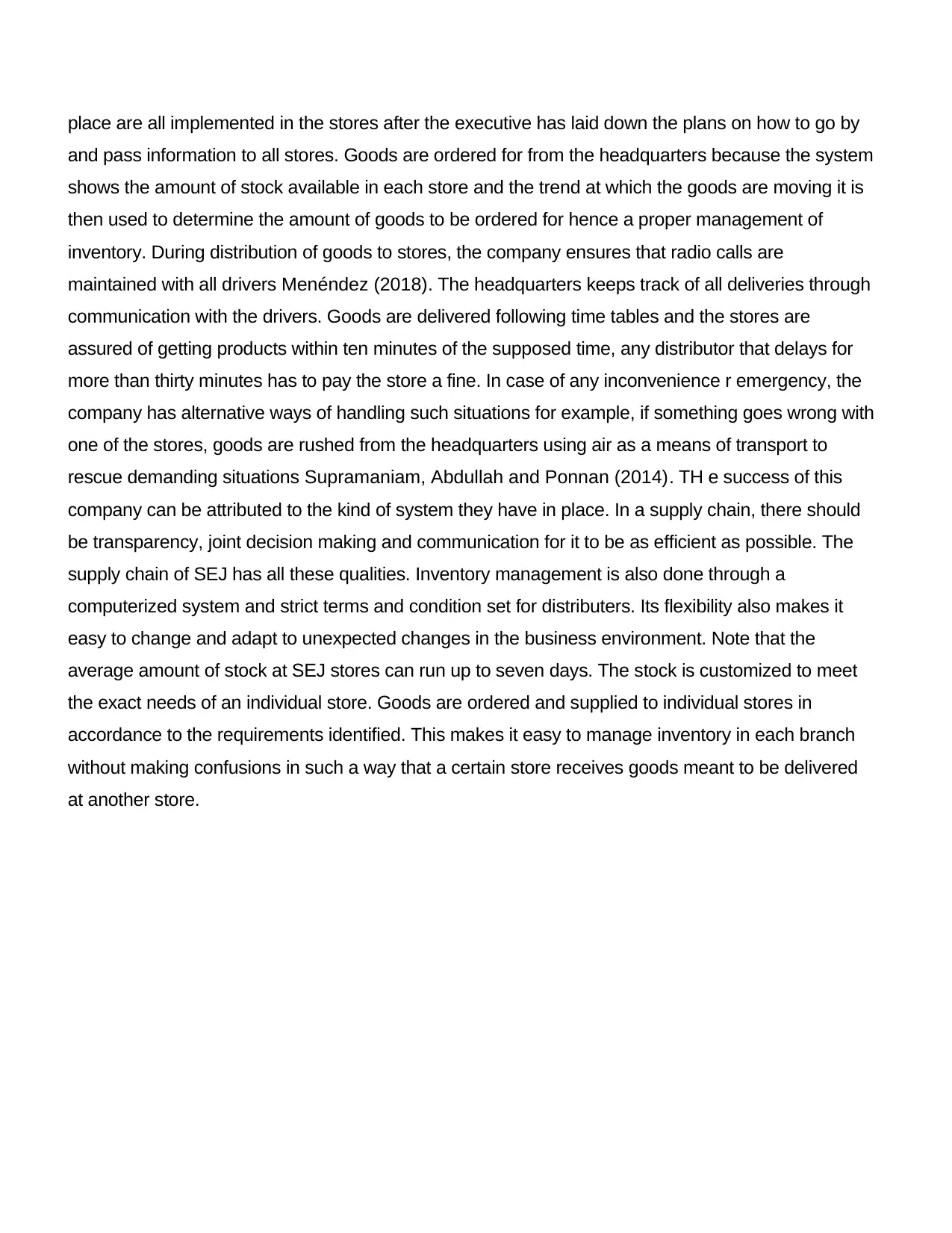
place are all implemented in the stores after the executive has laid down the plans on how to go by
and pass information to all stores. Goods are ordered for from the headquarters because the system
shows the amount of stock available in each store and the trend at which the goods are moving it is
then used to determine the amount of goods to be ordered for hence a proper management of
inventory. During distribution of goods to stores, the company ensures that radio calls are
maintained with all drivers Menéndez (2018). The headquarters keeps track of all deliveries through
communication with the drivers. Goods are delivered following time tables and the stores are
assured of getting products within ten minutes of the supposed time, any distributor that delays for
more than thirty minutes has to pay the store a fine. In case of any inconvenience r emergency, the
company has alternative ways of handling such situations for example, if something goes wrong with
one of the stores, goods are rushed from the headquarters using air as a means of transport to
rescue demanding situations Supramaniam, Abdullah and Ponnan (2014). TH e success of this
company can be attributed to the kind of system they have in place. In a supply chain, there should
be transparency, joint decision making and communication for it to be as efficient as possible. The
supply chain of SEJ has all these qualities. Inventory management is also done through a
computerized system and strict terms and condition set for distributers. Its flexibility also makes it
easy to change and adapt to unexpected changes in the business environment. Note that the
average amount of stock at SEJ stores can run up to seven days. The stock is customized to meet
the exact needs of an individual store. Goods are ordered and supplied to individual stores in
accordance to the requirements identified. This makes it easy to manage inventory in each branch
without making confusions in such a way that a certain store receives goods meant to be delivered
at another store.
and pass information to all stores. Goods are ordered for from the headquarters because the system
shows the amount of stock available in each store and the trend at which the goods are moving it is
then used to determine the amount of goods to be ordered for hence a proper management of
inventory. During distribution of goods to stores, the company ensures that radio calls are
maintained with all drivers Menéndez (2018). The headquarters keeps track of all deliveries through
communication with the drivers. Goods are delivered following time tables and the stores are
assured of getting products within ten minutes of the supposed time, any distributor that delays for
more than thirty minutes has to pay the store a fine. In case of any inconvenience r emergency, the
company has alternative ways of handling such situations for example, if something goes wrong with
one of the stores, goods are rushed from the headquarters using air as a means of transport to
rescue demanding situations Supramaniam, Abdullah and Ponnan (2014). TH e success of this
company can be attributed to the kind of system they have in place. In a supply chain, there should
be transparency, joint decision making and communication for it to be as efficient as possible. The
supply chain of SEJ has all these qualities. Inventory management is also done through a
computerized system and strict terms and condition set for distributers. Its flexibility also makes it
easy to change and adapt to unexpected changes in the business environment. Note that the
average amount of stock at SEJ stores can run up to seven days. The stock is customized to meet
the exact needs of an individual store. Goods are ordered and supplied to individual stores in
accordance to the requirements identified. This makes it easy to manage inventory in each branch
without making confusions in such a way that a certain store receives goods meant to be delivered
at another store.
⊘ This is a preview!⊘
Do you want full access?
Subscribe today to unlock all pages.

Trusted by 1+ million students worldwide
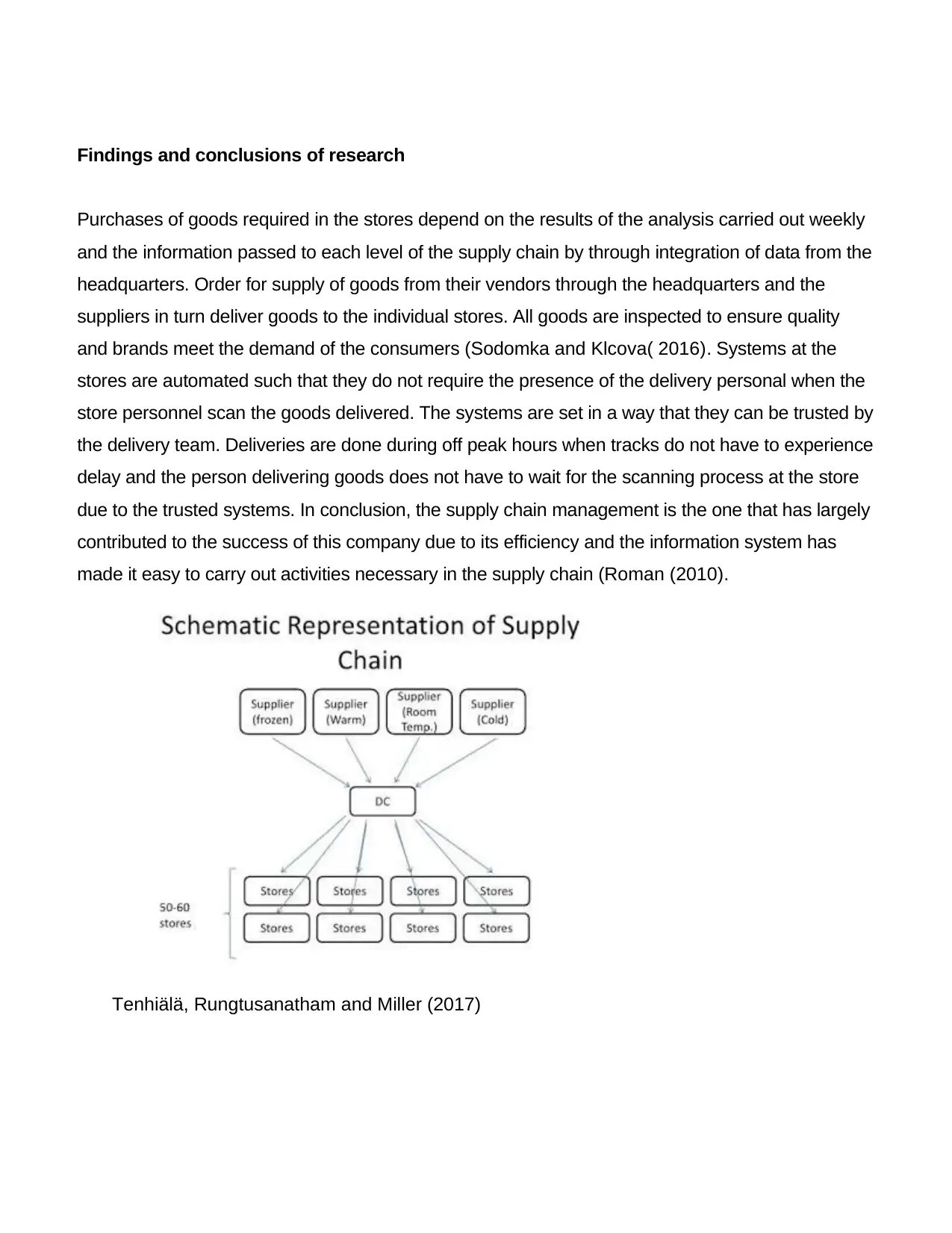
Findings and conclusions of research
Purchases of goods required in the stores depend on the results of the analysis carried out weekly
and the information passed to each level of the supply chain by through integration of data from the
headquarters. Order for supply of goods from their vendors through the headquarters and the
suppliers in turn deliver goods to the individual stores. All goods are inspected to ensure quality
and brands meet the demand of the consumers (Sodomka and Klcova( 2016). Systems at the
stores are automated such that they do not require the presence of the delivery personal when the
store personnel scan the goods delivered. The systems are set in a way that they can be trusted by
the delivery team. Deliveries are done during off peak hours when tracks do not have to experience
delay and the person delivering goods does not have to wait for the scanning process at the store
due to the trusted systems. In conclusion, the supply chain management is the one that has largely
contributed to the success of this company due to its efficiency and the information system has
made it easy to carry out activities necessary in the supply chain (Roman (2010).
Tenhiälä, Rungtusanatham and Miller (2017)
Purchases of goods required in the stores depend on the results of the analysis carried out weekly
and the information passed to each level of the supply chain by through integration of data from the
headquarters. Order for supply of goods from their vendors through the headquarters and the
suppliers in turn deliver goods to the individual stores. All goods are inspected to ensure quality
and brands meet the demand of the consumers (Sodomka and Klcova( 2016). Systems at the
stores are automated such that they do not require the presence of the delivery personal when the
store personnel scan the goods delivered. The systems are set in a way that they can be trusted by
the delivery team. Deliveries are done during off peak hours when tracks do not have to experience
delay and the person delivering goods does not have to wait for the scanning process at the store
due to the trusted systems. In conclusion, the supply chain management is the one that has largely
contributed to the success of this company due to its efficiency and the information system has
made it easy to carry out activities necessary in the supply chain (Roman (2010).
Tenhiälä, Rungtusanatham and Miller (2017)
Paraphrase This Document
Need a fresh take? Get an instant paraphrase of this document with our AI Paraphraser
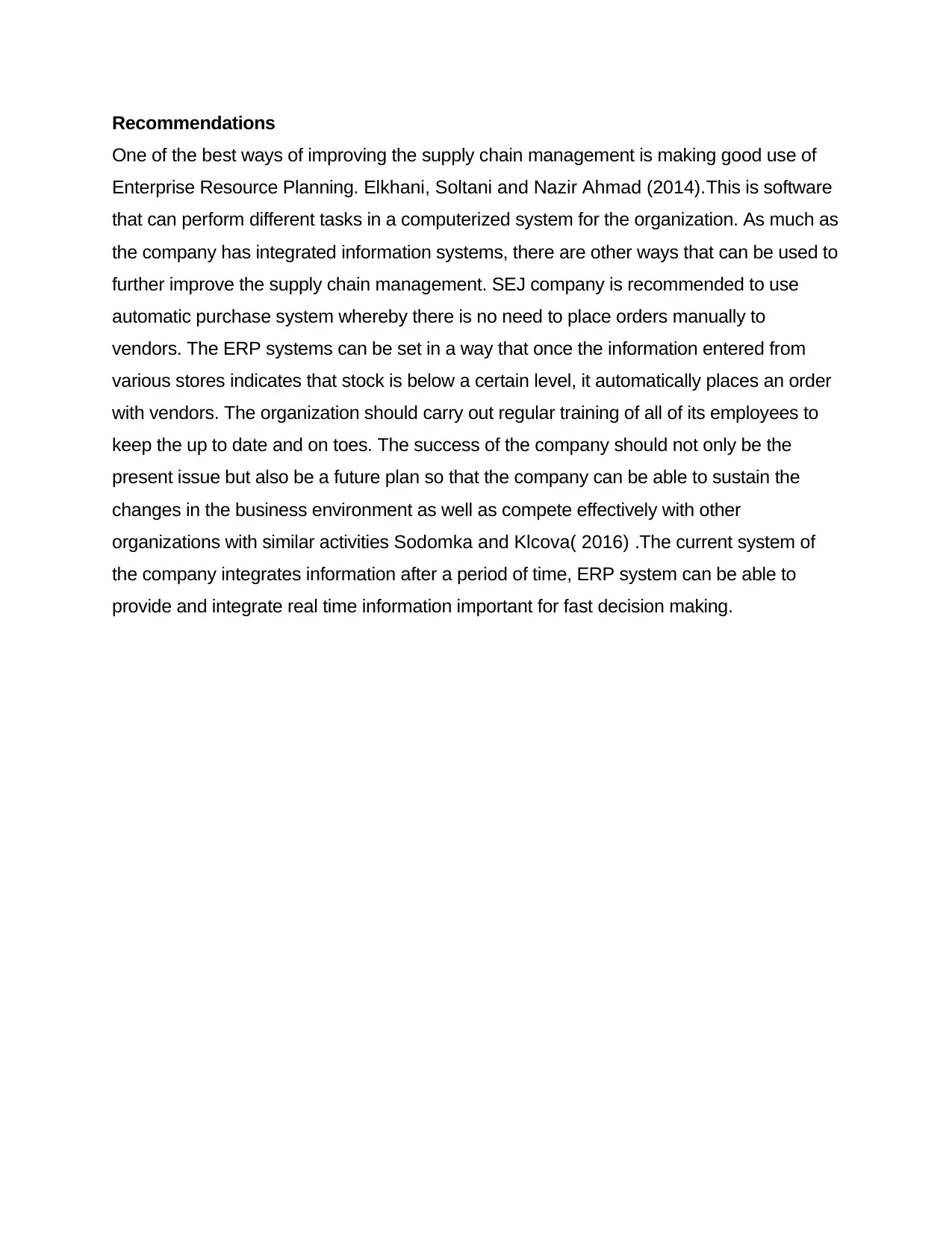
Recommendations
One of the best ways of improving the supply chain management is making good use of
Enterprise Resource Planning. Elkhani, Soltani and Nazir Ahmad (2014).This is software
that can perform different tasks in a computerized system for the organization. As much as
the company has integrated information systems, there are other ways that can be used to
further improve the supply chain management. SEJ company is recommended to use
automatic purchase system whereby there is no need to place orders manually to
vendors. The ERP systems can be set in a way that once the information entered from
various stores indicates that stock is below a certain level, it automatically places an order
with vendors. The organization should carry out regular training of all of its employees to
keep the up to date and on toes. The success of the company should not only be the
present issue but also be a future plan so that the company can be able to sustain the
changes in the business environment as well as compete effectively with other
organizations with similar activities Sodomka and Klcova( 2016) .The current system of
the company integrates information after a period of time, ERP system can be able to
provide and integrate real time information important for fast decision making.
One of the best ways of improving the supply chain management is making good use of
Enterprise Resource Planning. Elkhani, Soltani and Nazir Ahmad (2014).This is software
that can perform different tasks in a computerized system for the organization. As much as
the company has integrated information systems, there are other ways that can be used to
further improve the supply chain management. SEJ company is recommended to use
automatic purchase system whereby there is no need to place orders manually to
vendors. The ERP systems can be set in a way that once the information entered from
various stores indicates that stock is below a certain level, it automatically places an order
with vendors. The organization should carry out regular training of all of its employees to
keep the up to date and on toes. The success of the company should not only be the
present issue but also be a future plan so that the company can be able to sustain the
changes in the business environment as well as compete effectively with other
organizations with similar activities Sodomka and Klcova( 2016) .The current system of
the company integrates information after a period of time, ERP system can be able to
provide and integrate real time information important for fast decision making.
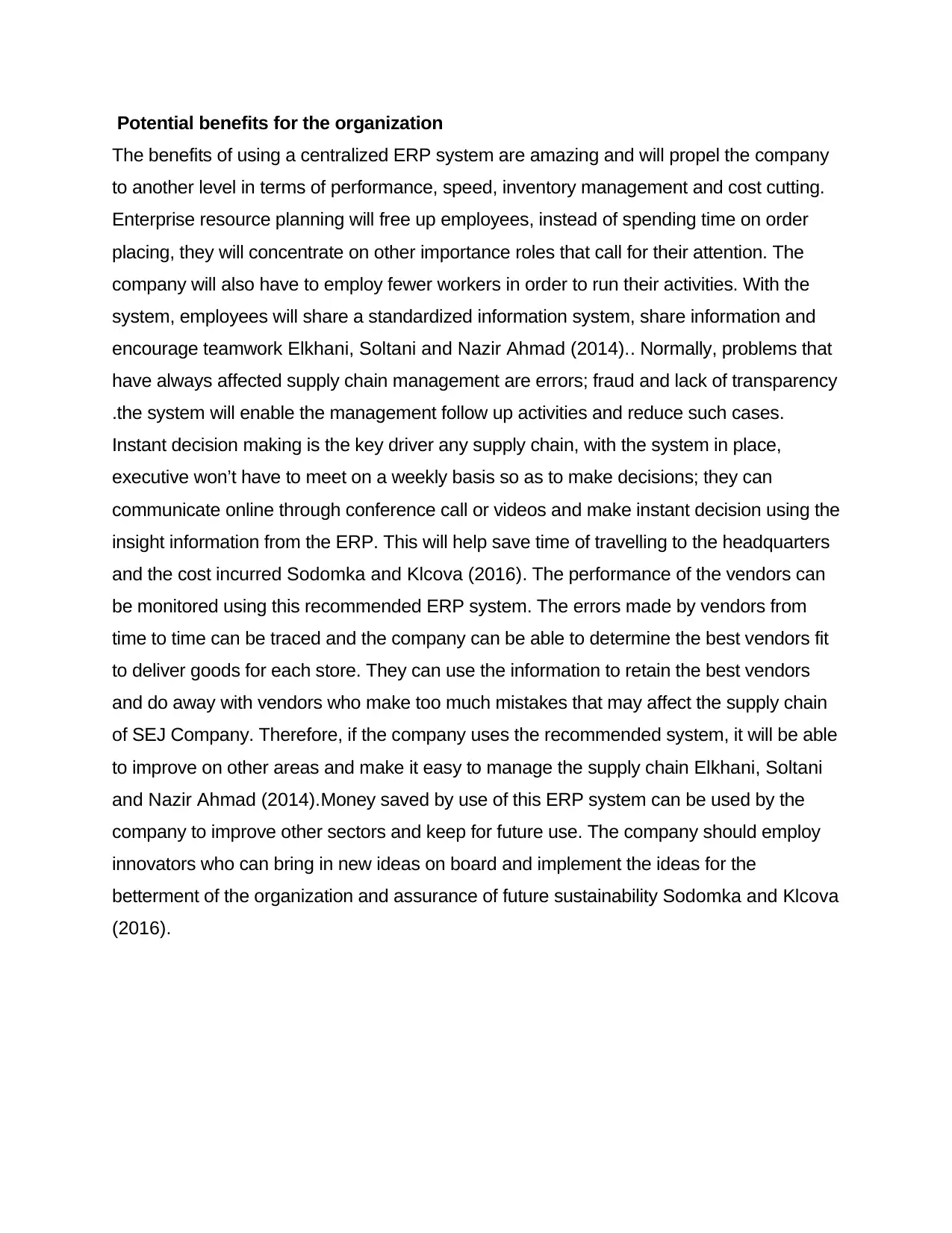
Potential benefits for the organization
The benefits of using a centralized ERP system are amazing and will propel the company
to another level in terms of performance, speed, inventory management and cost cutting.
Enterprise resource planning will free up employees, instead of spending time on order
placing, they will concentrate on other importance roles that call for their attention. The
company will also have to employ fewer workers in order to run their activities. With the
system, employees will share a standardized information system, share information and
encourage teamwork Elkhani, Soltani and Nazir Ahmad (2014).. Normally, problems that
have always affected supply chain management are errors; fraud and lack of transparency
.the system will enable the management follow up activities and reduce such cases.
Instant decision making is the key driver any supply chain, with the system in place,
executive won’t have to meet on a weekly basis so as to make decisions; they can
communicate online through conference call or videos and make instant decision using the
insight information from the ERP. This will help save time of travelling to the headquarters
and the cost incurred Sodomka and Klcova (2016). The performance of the vendors can
be monitored using this recommended ERP system. The errors made by vendors from
time to time can be traced and the company can be able to determine the best vendors fit
to deliver goods for each store. They can use the information to retain the best vendors
and do away with vendors who make too much mistakes that may affect the supply chain
of SEJ Company. Therefore, if the company uses the recommended system, it will be able
to improve on other areas and make it easy to manage the supply chain Elkhani, Soltani
and Nazir Ahmad (2014).Money saved by use of this ERP system can be used by the
company to improve other sectors and keep for future use. The company should employ
innovators who can bring in new ideas on board and implement the ideas for the
betterment of the organization and assurance of future sustainability Sodomka and Klcova
(2016).
The benefits of using a centralized ERP system are amazing and will propel the company
to another level in terms of performance, speed, inventory management and cost cutting.
Enterprise resource planning will free up employees, instead of spending time on order
placing, they will concentrate on other importance roles that call for their attention. The
company will also have to employ fewer workers in order to run their activities. With the
system, employees will share a standardized information system, share information and
encourage teamwork Elkhani, Soltani and Nazir Ahmad (2014).. Normally, problems that
have always affected supply chain management are errors; fraud and lack of transparency
.the system will enable the management follow up activities and reduce such cases.
Instant decision making is the key driver any supply chain, with the system in place,
executive won’t have to meet on a weekly basis so as to make decisions; they can
communicate online through conference call or videos and make instant decision using the
insight information from the ERP. This will help save time of travelling to the headquarters
and the cost incurred Sodomka and Klcova (2016). The performance of the vendors can
be monitored using this recommended ERP system. The errors made by vendors from
time to time can be traced and the company can be able to determine the best vendors fit
to deliver goods for each store. They can use the information to retain the best vendors
and do away with vendors who make too much mistakes that may affect the supply chain
of SEJ Company. Therefore, if the company uses the recommended system, it will be able
to improve on other areas and make it easy to manage the supply chain Elkhani, Soltani
and Nazir Ahmad (2014).Money saved by use of this ERP system can be used by the
company to improve other sectors and keep for future use. The company should employ
innovators who can bring in new ideas on board and implement the ideas for the
betterment of the organization and assurance of future sustainability Sodomka and Klcova
(2016).
⊘ This is a preview!⊘
Do you want full access?
Subscribe today to unlock all pages.

Trusted by 1+ million students worldwide
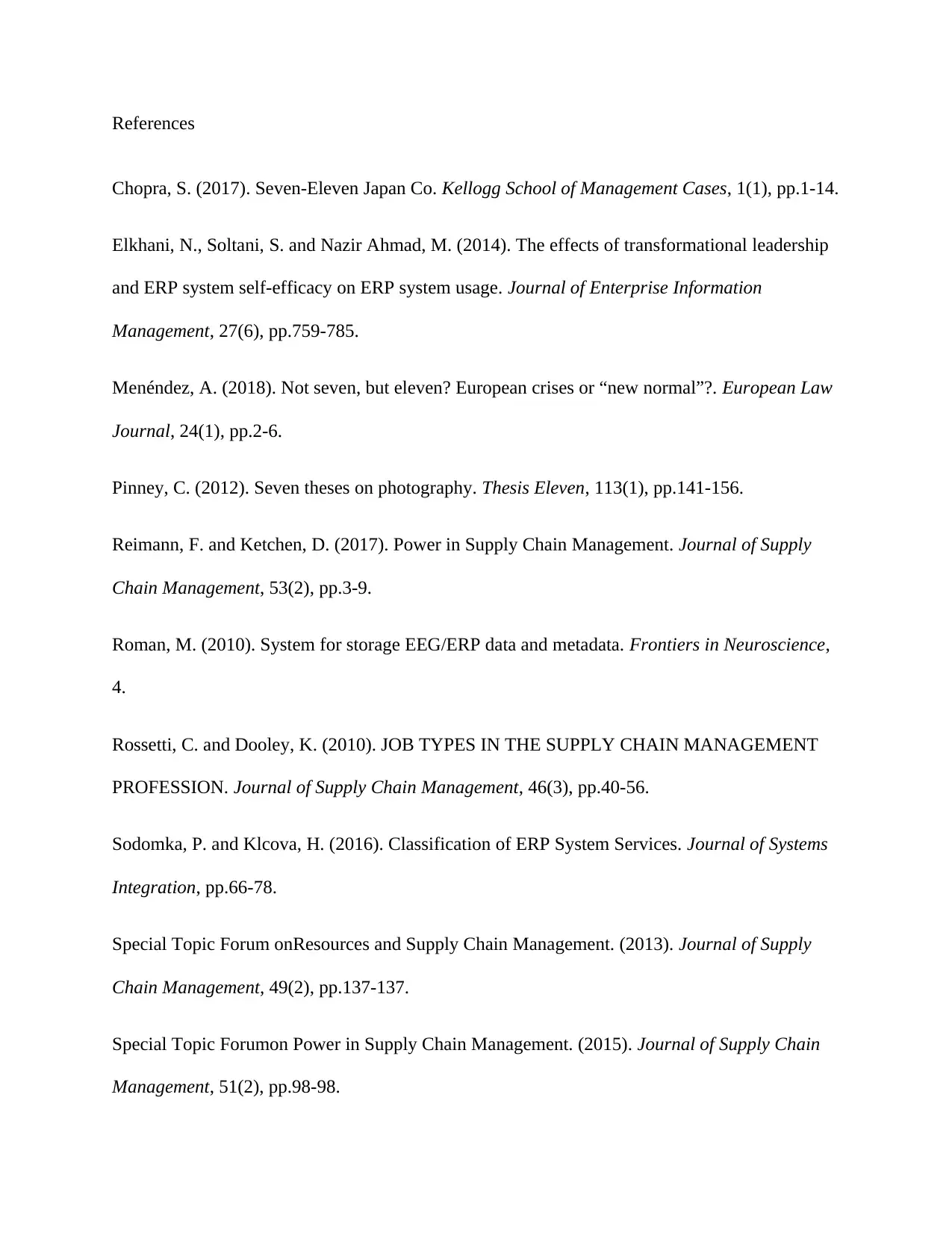
References
Chopra, S. (2017). Seven-Eleven Japan Co. Kellogg School of Management Cases, 1(1), pp.1-14.
Elkhani, N., Soltani, S. and Nazir Ahmad, M. (2014). The effects of transformational leadership
and ERP system self-efficacy on ERP system usage. Journal of Enterprise Information
Management, 27(6), pp.759-785.
Menéndez, A. (2018). Not seven, but eleven? European crises or “new normal”?. European Law
Journal, 24(1), pp.2-6.
Pinney, C. (2012). Seven theses on photography. Thesis Eleven, 113(1), pp.141-156.
Reimann, F. and Ketchen, D. (2017). Power in Supply Chain Management. Journal of Supply
Chain Management, 53(2), pp.3-9.
Roman, M. (2010). System for storage EEG/ERP data and metadata. Frontiers in Neuroscience,
4.
Rossetti, C. and Dooley, K. (2010). JOB TYPES IN THE SUPPLY CHAIN MANAGEMENT
PROFESSION. Journal of Supply Chain Management, 46(3), pp.40-56.
Sodomka, P. and Klcova, H. (2016). Classification of ERP System Services. Journal of Systems
Integration, pp.66-78.
Special Topic Forum onResources and Supply Chain Management. (2013). Journal of Supply
Chain Management, 49(2), pp.137-137.
Special Topic Forumon Power in Supply Chain Management. (2015). Journal of Supply Chain
Management, 51(2), pp.98-98.
Chopra, S. (2017). Seven-Eleven Japan Co. Kellogg School of Management Cases, 1(1), pp.1-14.
Elkhani, N., Soltani, S. and Nazir Ahmad, M. (2014). The effects of transformational leadership
and ERP system self-efficacy on ERP system usage. Journal of Enterprise Information
Management, 27(6), pp.759-785.
Menéndez, A. (2018). Not seven, but eleven? European crises or “new normal”?. European Law
Journal, 24(1), pp.2-6.
Pinney, C. (2012). Seven theses on photography. Thesis Eleven, 113(1), pp.141-156.
Reimann, F. and Ketchen, D. (2017). Power in Supply Chain Management. Journal of Supply
Chain Management, 53(2), pp.3-9.
Roman, M. (2010). System for storage EEG/ERP data and metadata. Frontiers in Neuroscience,
4.
Rossetti, C. and Dooley, K. (2010). JOB TYPES IN THE SUPPLY CHAIN MANAGEMENT
PROFESSION. Journal of Supply Chain Management, 46(3), pp.40-56.
Sodomka, P. and Klcova, H. (2016). Classification of ERP System Services. Journal of Systems
Integration, pp.66-78.
Special Topic Forum onResources and Supply Chain Management. (2013). Journal of Supply
Chain Management, 49(2), pp.137-137.
Special Topic Forumon Power in Supply Chain Management. (2015). Journal of Supply Chain
Management, 51(2), pp.98-98.
Paraphrase This Document
Need a fresh take? Get an instant paraphrase of this document with our AI Paraphraser
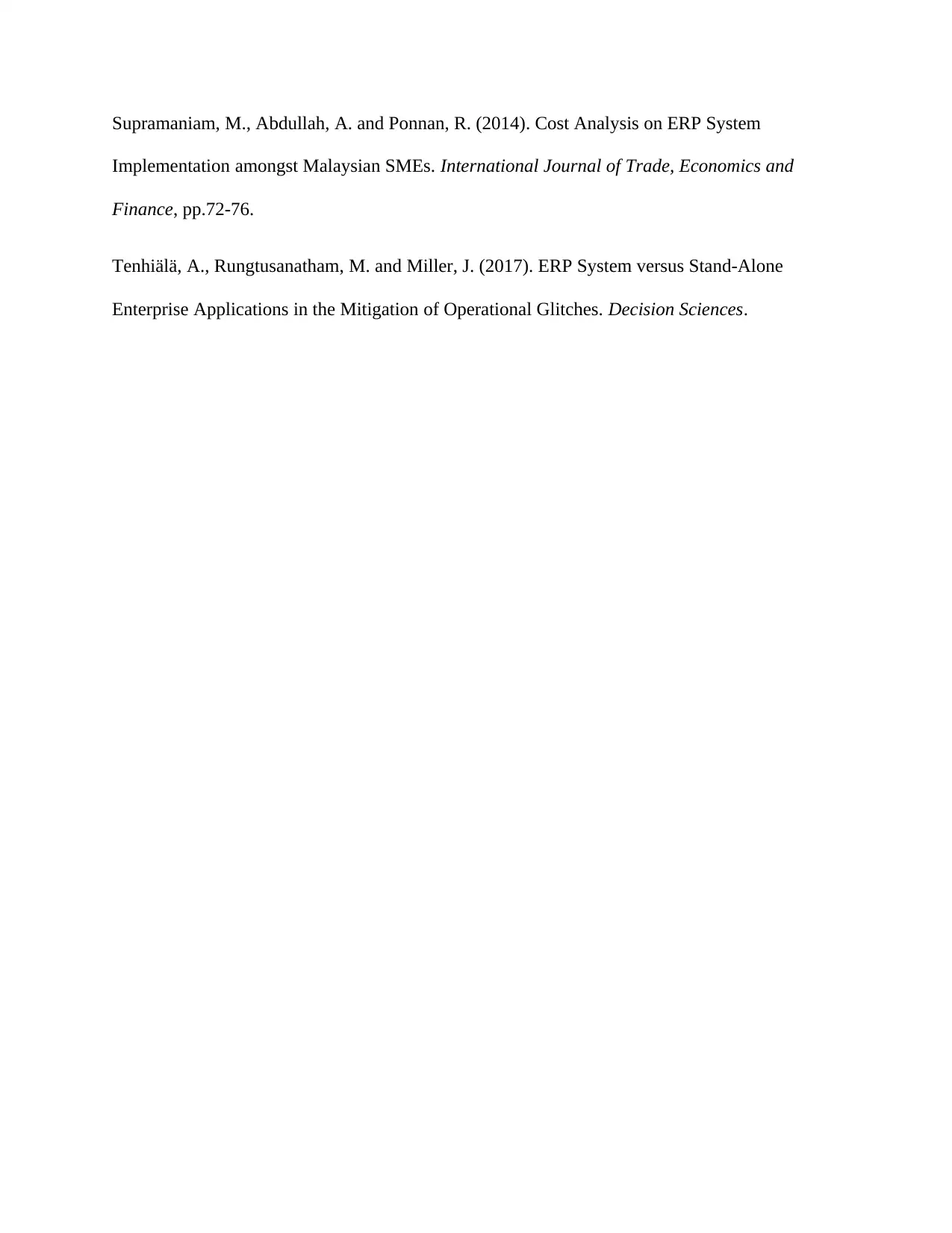
Supramaniam, M., Abdullah, A. and Ponnan, R. (2014). Cost Analysis on ERP System
Implementation amongst Malaysian SMEs. International Journal of Trade, Economics and
Finance, pp.72-76.
Tenhiälä, A., Rungtusanatham, M. and Miller, J. (2017). ERP System versus Stand-Alone
Enterprise Applications in the Mitigation of Operational Glitches. Decision Sciences.
Implementation amongst Malaysian SMEs. International Journal of Trade, Economics and
Finance, pp.72-76.
Tenhiälä, A., Rungtusanatham, M. and Miller, J. (2017). ERP System versus Stand-Alone
Enterprise Applications in the Mitigation of Operational Glitches. Decision Sciences.
1 out of 8
Related Documents
Your All-in-One AI-Powered Toolkit for Academic Success.
+13062052269
info@desklib.com
Available 24*7 on WhatsApp / Email
![[object Object]](/_next/static/media/star-bottom.7253800d.svg)
Unlock your academic potential
Copyright © 2020–2025 A2Z Services. All Rights Reserved. Developed and managed by ZUCOL.





